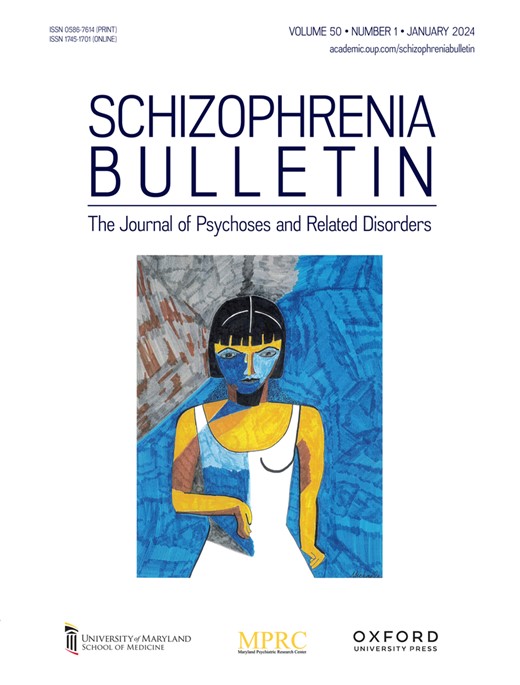主要精神病的共同结构:精神分裂症、分裂情感障碍和双相情感障碍网络结构的相似之处多于不同之处
IF 5.3
1区 医学
Q1 PSYCHIATRY
引用次数: 0
摘要
背景与假设 关于主要精神病(如双相情感障碍、精神分裂症和分裂情感障碍)是一种具有不同表现形式的疾病,还是不同的疾病实体,一直存在着长达一个世纪的争论。使用维度模型的传统方法并没有提供决定性的结论。在此,我们通过研究情感和精神综合征的网络结构来解决这一问题。设计 我们从三个数据集中提取了 1882 名患有精神病的双相情感障碍、精神分裂情感障碍和精神分裂症患者的可比症状数据:B-SNIP 1、B-SNIP2 和 PARDIP。从正负综合量表、YMRS 和蒙哥马利-阿斯伯格抑郁评定量表中选择了 26 个项目进行分析,分析时采用了一种原则性方法来消除重叠/多余的项目。对高斯图形模型进行了估计和稳定性评估,并使用引导探索性图形分析确定了它们的群落。通过网络比较测试对网络结构和全局密度进行了比较。结果 各诊断组的网络结构高度相似(ramp &;gt;80)。在所有诊断中,躁狂症状与阳性症状的关联度更高,而抑郁症状与阴性症状的关联度更高。抑郁症状和阴性症状是抑郁和精神病群体的最强指标。从理论上讲,症状之间网络边缘权重的变化与思维紊乱和悲观思维有关。结论 双相情感障碍、分裂情感障碍和精神分裂症的症状表现是由同样广泛的精神病理学结构构成的。今后的研究应在本研究结果的基础上,采用能够检测因果关系的方法,比较不同诊断组症状之间的具体相互关系。本文章由计算机程序翻译,如有差异,请以英文原文为准。
The Common Structure of the Major Psychoses: More Similarities Than Differences in the Network Structures of Schizophrenia, Schizoaffective Disorder, and Psychotic Bipolar Disorder
Background and Hypothesis There has been a century-long debate about whether the major psychoses (eg, bipolar disorder, schizophrenia, and schizoaffective disorder) are one disorder with various manifestations or different disease entities. Traditional approaches using dimensional models have not provided decisive findings. Here, we address this question by examining the network constellation of affective and psychotic syndromes. Design Comparable symptom data of 1882 patients with psychotic bipolar disorder, schizoaffective disorders, and schizophrenia were extracted from three datasets: B-SNIP 1, B-SNIP2, and PARDIP. Twenty-six items from the Positive and Negative Syndrome Scale, YMRS, and the Montgomery-Asberg Depression Rating Scale were selected for the analysis using a principled approach to eliminate overlapping/redundant items. Gaussian graphical models were estimated and assessed for stability, and their communities were identified using bootstrapped exploratory graph analysis. The structures and global densities of the networks were compared with network comparison tests. Results The network structures were highly similar (r >. 80) across diagnostic groups. For all diagnoses, manic symptoms were more connected with positive symptoms while depressive symptoms were more linked with negative symptoms. The depressive and negative symptoms were the strongest indicators of depressive and psychotic communities. Theoretically interesting variability in network edge weights between symptoms was found relating to thought disorder and pessimistic thinking. Conclusions The same broad structure of psychopathology underlies the symptom expressions of bipolar disorder, schizoaffective disorder, and schizophrenia. Future studies should build on the present finding by comparing specific inter-relations between symptoms in the different diagnostic groups using methods capable of detecting causality.
求助全文
通过发布文献求助,成功后即可免费获取论文全文。
去求助
来源期刊

Schizophrenia Bulletin
医学-精神病学
CiteScore
11.40
自引率
6.10%
发文量
163
审稿时长
4-8 weeks
期刊介绍:
Schizophrenia Bulletin seeks to review recent developments and empirically based hypotheses regarding the etiology and treatment of schizophrenia. We view the field as broad and deep, and will publish new knowledge ranging from the molecular basis to social and cultural factors. We will give new emphasis to translational reports which simultaneously highlight basic neurobiological mechanisms and clinical manifestations. Some of the Bulletin content is invited as special features or manuscripts organized as a theme by special guest editors. Most pages of the Bulletin are devoted to unsolicited manuscripts of high quality that report original data or where we can provide a special venue for a major study or workshop report. Supplement issues are sometimes provided for manuscripts reporting from a recent conference.
 求助内容:
求助内容: 应助结果提醒方式:
应助结果提醒方式:


